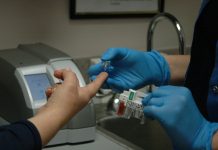
Sugar is a carbohydrate and 1 level teaspoon has 4 grams of carbohydrate. There is not a specific way to predict how many grams of sugar is in a food with x amount of carbohydrate as it depends on whether the sugar is naturally occurring or added to a packaged food. The Nutrition Facts on a
food label will list sugar grams from all sources (natural occurring or added sugar) as part of the carbohydrate in a food. But counting sugar grams is not necessary for a person with diabetes.
Starch, fruit, and milk diabetic exchanges have approximately the same number of grams of carbohydrate and each is counted as 1 carbohydrate choice (serving size varies with the food). Diabetic nutrition therapy is designed to count carbohydrate choices (1 carbohydrate choice has 15 grams carbohydrate). So a person on a carbohydrate counting eating plan counts the number of starch, fruit, and milk exchange servings eaten each meal each day using a plan that keeps their blood glucose within normal ranges which is 70 to 105 milligrams per deciliter. Usually, 2 to 4 carbohydrate choices (depending on calorie and weight goals) are eaten per meal and 1 carbohydrate choice as a snack between meals to spread out the carbohydrate intake over a day which helps to even out highs and lows of blood glucose levels.
I would suggest your mom make an appointment to see a registered dietitian to help plan her meals and determine the number of carbohydrate choices per day based on her weight and blood glucose goals. The dietitian can provide her with a booklet on carbohydrate counting from the Academy of Nutrition and Dietetics. The booklets Basic or Advanced Carbohydrate Counting) explains how carbohydrate counting works.


